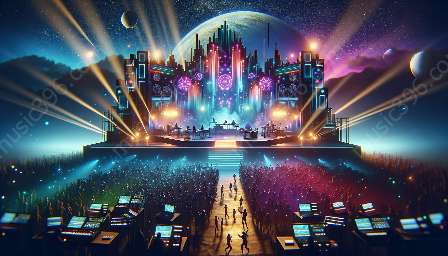Electronic music has significantly challenged traditional music norms, forming a unique space within the larger music industry. This evolution has sparked criticism and controversy, influencing the way we perceive and experience music. As we delve into the world of electronic music, this article uncovers the historical, cultural, and technological factors that have shaped its boundary-pushing nature.
The Genesis of Electronic Music
Electronic music emerged as a genre with its roots in the early 20th century, driven by a desire to explore new sonic possibilities through technology. The advent of electronic instruments, such as the theremin and the synthesizer, allowed artists to break free from the constraints of traditional acoustic instruments and create sounds that were previously unimaginable. This revolutionary approach to music production laid the foundation for a paradigm shift in the industry.
Breaking the Mold: Challenging Traditional Notions of Instrumentation
One of the ways electronic music has challenged traditional norms is through its transformative approach to instrumentation. While conventional music heavily relies on physical instruments, electronic music embraces digital synthesizers, drum machines, and software-based production tools. This departure from conventional instruments has redefined the boundaries of what can be considered music, inviting a new wave of creativity and experimentation.
Shaping New Sounds: The Exploration of Timbre and Texture
Electronic music has also challenged traditional music norms by focusing on the manipulation of timbre and texture. Unlike traditional music, which often prioritizes melodic and harmonic structures, electronic music places equal emphasis on the sonic intricacies of sound. Through techniques such as sound manipulation, sampling, and signal processing, electronic artists have pushed the boundaries of auditory perception, creating immersive sonic landscapes that defy traditional music conventions.
Disrupting Performance Practices: Live Electronic Music and DJ Culture
The rise of electronic music has disrupted traditional performance practices, giving rise to live electronic music performances and the emergence of DJ culture. With the advent of advanced audio technology, electronic artists have been able to craft dynamic and interactive live experiences that blur the line between performer and audience. The fusion of music, visual art, and digital interactivity has redefined the traditional concert experience, sparking controversy and debate about the authenticity of electronic music performances.
Criticism and Controversy: Artistic Authenticity and the Mainstream
The evolution of electronic music has not been without its share of criticism and controversy. Traditionalists within the music industry have often questioned the artistic authenticity of electronic music, citing concerns about the overreliance on technology and the perceived lack of genuine musical expression. Additionally, the mainstream integration of electronic music has sparked debates about commercialization and cultural appropriation, with some arguing that the genre's essence has been diluted to cater to popular tastes.
Technological Advancements: Redefining the Role of the Artist
The rapid technological advancements in music production and distribution have redefined the role of the artist within the electronic music landscape. With the accessibility of digital audio workstations and online platforms, virtually anyone can create and release electronic music, challenging the traditional gatekeeping mechanisms of the music industry. This democratization of music production has both empowered aspiring artists and raised concerns about the oversaturation of the market and the diminishing value of original artistry.
Embracing Diversity: Cultural Fusion and Hybridization
Electronic music has become a melting pot of cultural fusion and hybridization, transcending traditional genre boundaries. The incorporation of global music influences, such as traditional instrumentation and vocal styles, has enriched the sonic tapestry of electronic music, leading to a diverse array of subgenres and stylistic innovations. However, this cross-cultural exchange has also raised questions about cultural authenticity and appropriation, prompting discourse about the ethical implications of blending diverse musical traditions.
Pushing Boundaries: The Future of Electronic Music
As electronic music continues to push boundaries and defy traditional norms, its impact on the music industry and popular culture remains significant. The ongoing evolution of technology, combined with the progressive experimentation of electronic artists, promises to shape the future of music in unprecedented ways. Whether through sonic innovation, cultural inclusivity, or technological disruption, electronic music continues to challenge the status quo, inviting both acclaim and controversy in its wake.


